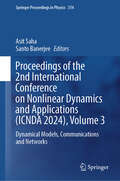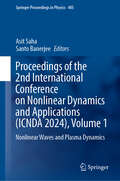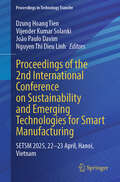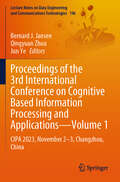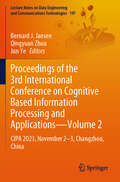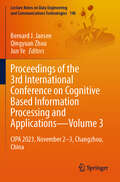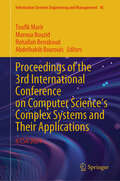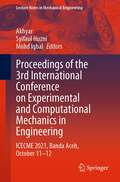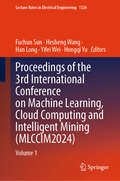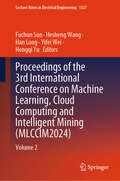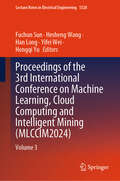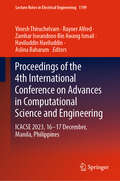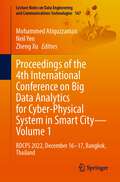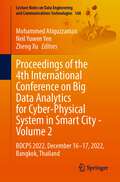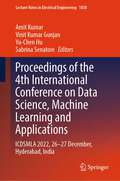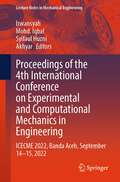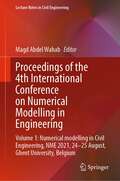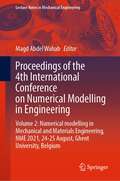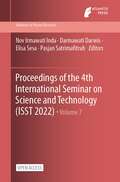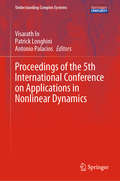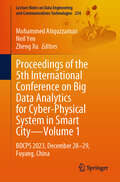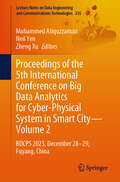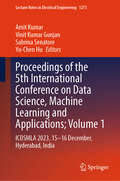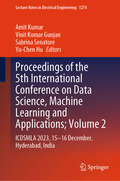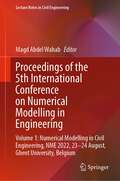- Table View
- List View
Proceedings of the 2nd International Conference on Nonlinear Dynamics and Applications: Dynamical Models, Communications and Networks (Springer Proceedings in Physics #314)
by Santo Banerjee Asit SahaThis book covers the latest advancements and applications of nonlinear dynamics in various fields of science and engineering, presenting a curated selection of peer-reviewed contributions at the 2nd International Conference on Nonlinear Dynamics and Applications (ICNDA 2024) at Sikkim Manipal Institute of Technology (SMIT). Organized by the Department of Mathematics, SMIT, SMU, this international conference provides a platform for scientists, researchers, and inventors to share their findings and exchange ideas in the ever-evolving field of nonlinear dynamics. This book comprises three volumes. Volume 3 focuses on graphs, networks, and communications. It covers topics such as optimization in control and neural systems; machine learning for signal analysis and classification; graph theory applications in science and engineering; analysis of wavelets and transforms in signal processing; and semiconductor devices and nanomaterials.
Proceedings of the 2nd International Conference on Nonlinear Dynamics and Applications: Nonlinear Waves and Plasma Dynamics (Springer Proceedings in Physics #405)
by Santo Banerjee Asit SahaThis book covers the latest advancements and applications of nonlinear dynamics in various fields of science and engineering, presenting a curated selection of peer-reviewed contributions at the 2nd International Conference on Nonlinear Dynamics and Applications (ICNDA 2024) at Sikkim Manipal Institute of Technology (SMIT). Organized by the Department of Mathematics, SMIT, SMU, this international conference provides a platform for scientists, researchers, and inventors to share their findings and exchange ideas in the ever-evolving field of nonlinear dynamics. This book comprises three volumes. Volume 1 focuses on the investigation of nonlinear waves and plasma dynamics. It covers topics such as strong Landau damping, electron plasma waves, ion-acoustic waves, dusty plasma, dust-acoustic waves, dust-ion-acoustic waves, kinetic Alfven waves, solitary wave, shock waves, periodic wave, cnoidal wave, superperiodic wave, soliton, resonance, lump soliton, multi-soliton, breather wave, upper hybrid wave, atmospheric internal wave, mathematical and analytical methods, quantum and relativistic plasmas, wave instabilities and interactions, fractional and complex systems, nonlinear optical phenomena, Gaussian laser beam, chaos and multistability, and other specific plasma studies.
Proceedings of the 2nd International Conference on Sustainability and Emerging Technologies for Smart Manufacturing: SETSM 2025, 22-23 April, Hanoi, Vietnam (Proceedings in Technology Transfer)
by Vijender Kumar Solanki Nguyen Thi Dieu Linh João Paulo Davim Dzung Hoang TienThis book presents peer reviewed articles from the 2nd International Conference on Sustainability and Emerging Technologies for Smart Manufacturing (SETSM 2025) held on 22-23 April at Hanoi in Vietnam. It presents latest research and innovation in Sustainability and emerging technologies for Smart Manufacturing, especially innovative solutions for development of sustainable and smart eco-systems in industries, healthcare and medicine. The book provides researchers, professionals, and decision-makers a platform to present their results on the following topics: Smart Manufacturing, Lean Manufacturing 4.0, Rapid Manufacturing and Cloud Manufacturing Sustainable Design and Manufacturing Advanced Materials Engineering Advanced Computational Modeling, Simulation and Optimization Additive Manufacturing, and Advanced machining processes Renewable energy and clean technologies, electric and hybrid technologies Autonomous vehicles, connected vehicles, and Intelligent Transportation Systems Mechatronics, robotics and digital twin Biomedical Engineering: Emerging technologies for medical diagnosis, treatments and rehabilitations, personalization and mass-personalization, Telehealth and in-home Healthcare. ICT—Information and Communications Technologies and applications for Smart Manufacturing and Industry 4.0.
Proceedings of the 3rd International Conference on Cognitive Based Information Processing and Applications–Volume 1: CIPA 2023, November 2–3, Changzhou, China (Lecture Notes on Data Engineering and Communications Technologies #196)
by Jun Ye Bernard J. Jansen Qingyuan ZhouThis book contains papers presented at the 3rd International Conference on Cognitive- based Information Processing and Applications (CIPA) in Changzhou, China, from November 2–3, 2023. The papers represent the various technological advancements in theory, technology and application of artificial intelligence, including precision mining, intelligent computing, deep learning, and all other theories, models, and technologies related to artificial intelligence. It caters to postgraduate students, researchers, and practitioners specializing and working in the area of cognitive-inspired computing and intelligent computing. The book represents Volume 1 for this conference proceedings, which consists of a 3-volume book series.
Proceedings of the 3rd International Conference on Cognitive Based Information Processing and Applications—Volume 2: CIPA 2023, November 2—3, Changzhou, China (Lecture Notes on Data Engineering and Communications Technologies #197)
by Jun Ye Bernard J. Jansen Qingyuan ZhouThis book contains papers presented at the 3rd International Conference on Cognitive- based Information Processing and Applications (CIPA) in Changzhou, China, from November 2–-3, 2023. The papers represent the various technological advancements in theory, technology and application of artificial intelligence, including precision mining, intelligent computing, deep learning, and all other theories, models, and technologies related to artificial intelligence. It caters to postgraduate students, researchers, and practitioners specializing and working in the area of cognitive-inspired computing and intelligent computing. The book represents Volume 2 for this conference proceedings, which consists of a 3-volume book series.
Proceedings of the 3rd International Conference on Cognitive Based Information Processing and Applications—Volume 3: CIPA 2023, November 2–3, Changzhou, China (Lecture Notes on Data Engineering and Communications Technologies #198)
by Jun Ye Bernard J. Jansen Qingyuan ZhouThis book contains papers presented at the 3rd International Conference on Cognitive- based Information Processing and Applications (CIPA) in Changzhou, China, from November 2–3, 2023. The papers represent the various technological advancements in theory, technology and application of artificial intelligence, including precision mining, intelligent computing, deep learning, and all other theories, models, and technologies related to artificial intelligence. It caters to postgraduate students, researchers, and practitioners specializing and working in the area of cognitive-inspired computing and intelligent computing. The book represents Volume 3 for this conference proceedings, which consists of a 3-volume book series.
Proceedings of the 3rd International Conference on Computer Science's Complex Systems and Their Applications: ICCSA’2024 (Information Systems Engineering and Management #45)
by Toufik Marir Maroua Bouzid Rohallah Benaboud Abdelhabib BourouisThis book features a diverse collection of high-quality papers covering the latest advancements in Artificial Intelligence and its Applications, Cybersecurity, Software Engineering, Emergent Technologies, Networks and Embedded Systems. The ICCSA&’2024 Proceedings bring together the latest research presented at the International Conference on Computer Science's Complex Systems and Their Applications (ICCSA&’2024), held on November 13–14, 2024, in Oum El Bouaghi, Algeria. Edited by leading experts in the field, this publication showcases innovative methodologies, theoretical breakthroughs, and real-world applications that shape the future of complex systems. With contributions from renowned researchers from around the world, who carefully selected the best research contributions for this international conference, the ICCSA&’2024 Proceedings stand as a valuable resource for academics, industry professionals, and students seeking insights into the evolving landscape of complex systems. Whether you are interested in complex systems and their engineering or their interdisciplinary applications, this book provides comprehensive and in-depth coverage of the most pressing challenges and transformative innovations in this field.
Proceedings of the 3rd International Conference on Experimental and Computational Mechanics in Engineering: ICECME 2021, Banda Aceh, October 11-12 (Lecture Notes in Mechanical Engineering)
by Akhyar Syifaul Huzni Mohd IqbalThis book gathers a selection of peer-reviewed papers presented at the 3rd International Conference on Experimental and Computational Mechanics in Engineering (ICECME 2021), held as a virtual conference and organized by Universitas Syiah Kuala, Banda Aceh, Indonesia, on October 11–12, 2021.This book, prepared by international scientists and engineers, covers the latest advances in computational mechanics, metallurgy and material science, energy systems, manufacturing processing systems, industrial and system engineering, biomechanics, artificial intelligence, micro-/nano-engineering, micro-electro-mechanical system, machine learning, mechatronics, and engineering design. This book is intended for academics, including graduate students and researchers, as well as industrial practitioners working in the areas of experimental and computational mechanics.
Proceedings of the 3rd International Conference on Machine Learning, Cloud Computing and Intelligent Mining: Volume 1 (Lecture Notes in Electrical Engineering #1326)
by Fuchun Sun Hesheng Wang Han Long Yifei Wei Hongqi YuThis proceedings book offers a meticulously curated compilation of peer-reviewed papers presented at the 3rd International Conference on Machine Learning, Cloud Computing and Intelligent Mining (MLCCIM2024). With a profound focus on these domains, this book serves as an invaluable resource for researchers, experts, professionals, and practitioners engaged in machine learning, control systems, robot, cloud computing, and intelligent mining techniques. The book facilitates a vibrant exchange of knowledge, enabling participants to unveil their pioneering research findings, showcase the outcomes of their latest projects, and engage in thought-provoking discussions to share perspectives and experiences.
Proceedings of the 3rd International Conference on Machine Learning, Cloud Computing and Intelligent Mining: Volume 2 (Lecture Notes in Electrical Engineering #1327)
by Fuchun Sun Hesheng Wang Han Long Yifei Wei Hongqi YuThe proceedings offer a meticulously curated compilation of peer-reviewed papers presented at the 3rd International Conference on Machine Learning, Cloud Computing and Intelligent Mining (MLCCIM2024). With a profound focus on these domains, this volume serves as an invaluable resource for researchers, experts, professionals, and practitioners engaged in machine learning, control systems, robot, cloud computing and intelligent mining techniques. The conference facilitated a vibrant exchange of knowledge, enabling participants to unveil their pioneering research findings, showcase the outcomes of their latest projects, and engage in thought-provoking discussions to share perspectives and experiences.
Proceedings of the 3rd International Conference on Machine Learning, Cloud Computing and Intelligent Mining: Volume 3 (Lecture Notes in Electrical Engineering #1328)
by Fuchun Sun Hesheng Wang Han Long Yifei Wei Hongqi YuThe proceedings offer a meticulously curated compilation of peer-reviewed papers presented at the 3rd International Conference on Machine Learning, Cloud Computing and Intelligent Mining (MLCCIM2024). With a profound focus on these domains, this volume serves as an invaluable resource for researchers, experts, professionals, and practitioners engaged in machine learning, control systems, robot, cloud computing and intelligent mining techniques. The conference facilitated a vibrant exchange of knowledge, enabling participants to unveil their pioneering research findings, showcase the outcomes of their latest projects, and engage in thought-provoking discussions to share perspectives and experiences.
Proceedings of the 4th International Conference on Advances in Computational Science and Engineering: ICACSE 2023, 16–17 December, Manila, Philippines (Lecture Notes in Electrical Engineering #1199)
by Rayner Alfred Haviluddin Haviluddin Zamhar Iswandono Bin Awang Ismail Aslina Baharum Vinesh ThiruchelvamThis book is the proceedings of the 4th International Conference on Advances in Computational Science and Engineering (ICACSE 2023, December 16–17, 2023, Manila, Philippines) and contains the selected peer-reviewed papers which reflect recent achievements in the field of application of the computational methods and algorithms in scientific research and engineering design. The papers presented covered topics such as advances in system integration, high-performance computing, modeling, and simulation, big data analytics, big data visualization, advanced networking and applications, cybersecurity, augmented and virtual reality, artificial intelligence and robotics, soft computing data science, and intelligent knowledge discovery. The book is useful, interesting, and informative for a wide range of scientists, engineers, and students.
Proceedings of the 4th International Conference on Big Data Analytics for Cyber-Physical System in Smart City - Volume 1: BDCPS 2022, December 16-17, Bangkok, Thailand (Lecture Notes on Data Engineering and Communications Technologies #167)
by Mohammed Atiquzzaman Zheng Xu Neil YenThis book gathers a selection of peer-reviewed papers presented at the 4th Big Data Analytics for Cyber-Physical System in Smart City (BDCPS 2022) conference, held in Bangkok, Thailand, on December 16–17. The contributions, prepared by an international team of scientists and engineers, cover the latest advances and challenges made in the field of big data analytics methods and approaches for the data-driven co-design of communication, computing, and control for smart cities. Given its scope, it offers a valuable resource for all researchers and professionals interested in big data, smart cities, and cyber-physical systems.
Proceedings of the 4th International Conference on Big Data Analytics for Cyber-Physical System in Smart City - Volume 2: BDCPS 2022, December 16–17, 2022, Bangkok, Thailand (Lecture Notes on Data Engineering and Communications Technologies #168)
by Mohammed Atiquzzaman Zheng Xu Neil Yuwen YenThis book gathers a selection of peer-reviewed papers presented at the 4th Big Data Analytics for Cyber-Physical System in Smart City (BDCPS 2022) conference held in Bangkok, Thailand, on December 16–17. The contributions, prepared by an international team of scientists and engineers, cover the latest advances and challenges made in the field of big data analytics methods and approaches for the data-driven co-design of communication, computing, and control for smart cities. Given its scope, it offers a valuable resource for all researchers and professionals interested in big data, smart cities, and cyber-physical systems.
Proceedings of the 4th International Conference on Data Science, Machine Learning and Applications: ICDSMLA 2022, 26–27 December, Hyderabad, India (Lecture Notes in Electrical Engineering #1038)
by Amit Kumar Yu-Chen Hu Vinit Kumar Gunjan Sabrina SenatoreThis book includes peer reviewed articles from the 4th International Conference on Data Science, Machine Learning and Applications, 2022, held at the Hyderabad Institute of Technology & Management on 26-27th December, India. ICDSMLA is one of the most prestigious conferences conceptualized in the field of Data Science & Machine Learning offering in-depth information on the latest developments in Artificial Intelligence, Machine Learning, Soft Computing, Human Computer Interaction, and various data science & machine learning applications. It provides a platform for academicians, scientists, researchers and professionals around the world to showcase broad range of perspectives, practices, and technical expertise in these fields. It offers participants the opportunity to stay informed about the latest developments in data science and machine learning.
Proceedings of the 4th International Conference on Experimental and Computational Mechanics in Engineering: ICECME 2022, Banda Aceh, September 14–15, 2022 (Lecture Notes in Mechanical Engineering)
by Akhyar Syifaul Huzni Irwansyah Mohd. IqbalThis book gathers a selection of peer-reviewed papers presented at the 4th International Conference on Experimental and Computational Mechanics in Engineering (ICECME 2022), held as a virtual conference and organized by Universitas Syiah Kuala, Banda Aceh, Indonesia, on September 14–15, 2022.This book, prepared by international scientists and engineers, covers the latest advances in computational mechanics, metallurgy and material science, energy systems, manufacturing processing systems, industrial and system engineering, biomechanics, artificial intelligence, micro-/nano-engineering, micro-electro-mechanical system, machine learning, mechatronics, and engineering design. This book is intended for academics, including graduate students and researchers, as well as industrial practitioners working in the areas of experimental and computational mechanics.
Proceedings of the 4th International Conference on Numerical Modelling in Engineering: Volume 1: Numerical modelling in Civil Engineering, NME 2021, 24-25 August, Ghent University, Belgium (Lecture Notes in Civil Engineering #217)
by Magd Abdel WahabThis book gathers outstanding papers on numerical modeling in Civil Engineering (Volume 1) as part of the 2-volume proceedings of the 4th International Conference on Numerical Modeling in Engineering (NME 2021), which was held in Ghent, Belgium, on 24-25 August 2021. The overall objective of the conference was to bring together international scientists and engineers in academia and industry from fields related to advanced numerical techniques, such as the finite element method (FEM), boundary element method (BEM), isogeometric analysis (IGA), etc., and their applications to a wide range of engineering disciplines. This volume covers numerical simulations with industrial civil engineering applications such as bridges and dams, cyclic loading, fluid dynamics, structural mechanics, geotechnical engineering, thermal analysis, reinforced concrete structures, steel structures, and composite structures.
Proceedings of the 4th International Conference on Numerical Modelling in Engineering: Volume 2: Numerical modelling in Mechanical and Materials Engineering, NME 2021, 24-25 August, Ghent University, Belgium (Lecture Notes in Mechanical Engineering)
by Magd Abdel WahabThis book gathers outstanding papers on numerical modeling in Mechanical Engineering (Volume 2) as part of the 2-volume proceedings of the 4th International Conference on Numerical Modeling in Engineering (NME 2021), which was held in Ghent, Belgium, on 24-25 August 2021. The overall objective of the conference was to bring together international scientists and engineers in academia and industry from fields related to advanced numerical techniques, such as the finite element method (FEM), boundary element method (BEM), isogeometric analysis (IGA), etc., and their applications to a wide range of engineering disciplines. This book addresses numerical simulations of various mechanical and materials engineering industrial applications such as aerospace applications, acoustic analysis, bio-mechanical applications, contact problems and wear, heat transfer analysis, vibration and dynamics, transient analysis, nonlinear analysis, composite materials, polymers, metal alloys, fracture mechanics, fatigue of materials, creep, mechanical behavior, micro-structure, phase transformation, and crystal plasticity.
Proceedings of the 4th International Seminar on Science and Technology (Advances in Physics Research #7)
by Nov Irmawati Inda Darmawati Darwis Elisa Sesa Pasjan SatrimafitrahThis is an open access book. ISST is an annual seminar organized regularly by Faculty of Mathematics and Natural Sciences, Tadulako University since 2018 in collaboration with University of Newcastle (Australia), University of Miyazaki (UoM), Physics Society of Indonesia, Indonesian Chemical Society (HKI) and Indonesian Mathematical Society (IndoMS). International seminar on science and technology aims to provide a high-level international forum for leading academicians, researchers, scientists, students, scholars, and practitioners to share the state of the art of knowledges, experiences, researches and applications on the aspect of advancement in Mathematics, Physics and Chemistry field.It is also serves to foster communication among academicians, researchers, scientists, students, scholars, and practitioners working in a wide variety of scientific areas with a common interest in improving science and technology in the field of mathematics, physics, and chemistry. Furthermore, this seminar can provide a premier interdisciplinary platform for academicians, researchers, scientists, students, scholars, and practitioners to present and discuss the most recent innovations, trends, and concerns as well as practical challenges encountered and solutions adopted in the fields of Mathematics, Physics and Chemistry.This seminar has been virtually held since 2020 due to covid-19 pandemic and is continuing to hold virtually following the advice and guidelines from government. However, due to the antusiasm of participants to attend the seminar “face to face”, hence this seminar will be held using hybrid style seminar by following healthcare guideline for covid-19.
Proceedings of the 5th International Conference on Applications in Nonlinear Dynamics (Understanding Complex Systems #6)
by Visarath In Antonio Palacios Patrick LonghiniThis book presents collaborative research presented by experts in the field of nonlinear science provides the reader with contemporary, cutting-edge, research works that bridge the gap between theory and device realizations of nonlinear phenomena. The conference provides a unique forum for applications of nonlinear systems while solving practical problems in science and engineering. Topics include: chaos gates, social networks, communication, sensors, lasers, molecular motors, biomedical anomalies, and stochastic resonance. This book provides a comprehensive report of the various research projects presented at the International Conference on Applications in Nonlinear Dynamics (ICAND 2018) held in Maui, Hawaii, 2018. It can be a valuable tool for scientists and engineering interested in connecting ideas and methods in nonlinear dynamics with actual design, fabrication and implementation of engineering applications or devices.
Proceedings of the 5th International Conference on Big Data Analytics for Cyber-Physical System in Smart City—Volume 1: BDCPS 2023, December 28–29, Fuyang, China (Lecture Notes on Data Engineering and Communications Technologies #234)
by Mohammed Atiquzzaman Zheng Xu Neil YenThis book gathers a selection of peer-reviewed papers presented at the 5th Big Data Analytics for Cyber-Physical System in Smart City (BDCPS 2023) conference, held in Fuyang, China, on December 28–29. The contributions, prepared by an international team of scientists and engineers, cover the latest advances and challenges made in the field of big data analytics methods and approaches for the data-driven co-design of communication, computing, and control for smart cities. Given its scope, it offers a valuable resource for all researchers and professionals interested in big data, smart cities, and cyber-physical systems.
Proceedings of the 5th International Conference on Big Data Analytics for Cyber-Physical System in Smart City—Volume 2: BDCPS 2023, December 28–29, Fuyang, China (Lecture Notes on Data Engineering and Communications Technologies #235)
by Mohammed Atiquzzaman Zheng Xu Neil YenThis book gathers a selection of peer-reviewed papers presented at the 5th Big Data Analytics for Cyber-Physical System in Smart City (BDCPS 2023) conference, held in Fuyang, China, on December 28–29. The contributions, prepared by an international team of scientists and engineers, cover the latest advances and challenges made in the field of big data analytics methods and approaches for the data-driven co-design of communication, computing, and control for smart cities. Given its scope, it offers a valuable resource for all researchers and professionals interested in big data, smart cities, and cyber-physical systems.
Proceedings of the 5th International Conference on Data Science, Machine Learning and Applications; Volume 1: ICDSMLA 2023, 15–16 December, Hyderabad, India (Lecture Notes in Electrical Engineering #1273)
by Amit Kumar Yu-Chen Hu Vinit Kumar Gunjan Sabrina SenatoreThis book (Volume 1) includes peer reviewed articles from the 5th International Conference on Data Science, Machine Learning and Applications, 2023, held at the G Narayanamma Institute of Technology and Sciences, Hyderabad on 15-16th December, India. ICDSMLA is one of the most prestigious conferences conceptualized in the field of Data Science & Machine Learning offering in-depth information on the latest developments in Artificial Intelligence, Machine Learning, Soft Computing, Human Computer Interaction, and various data science & machine learning applications. It provides a platform for academicians, scientists, researchers and professionals around the world to showcase broad range of perspectives, practices, and technical expertise in these fields. It offers participants the opportunity to stay informed about the latest developments in data science and machine learning.
Proceedings of the 5th International Conference on Data Science, Machine Learning and Applications; Volume 2: ICDSMLA 2023, 15–16 December, Hyderabad, India (Lecture Notes in Electrical Engineering #1274)
by Amit Kumar Yu-Chen Hu Vinit Kumar Gunjan Sabrina SenatoreThis book includes peer reviewed articles from the 5th International Conference on Data Science, Machine Learning and Applications, 2023, held at the G Narayanamma Institute of Technology and Sciences, Hyderabad on 15-16th December, India. ICDSMLA is one of the most prestigious conferences conceptualized in the field of Data Science & Machine Learning offering in-depth information on the latest developments in Artificial Intelligence, Machine Learning, Soft Computing, Human Computer Interaction, and various data science & machine learning applications. It provides a platform for academicians, scientists, researchers and professionals around the world to showcase broad range of perspectives, practices, and technical expertise in these fields. It offers participants the opportunity to stay informed about the latest developments in data science and machine learning.
Proceedings of the 5th International Conference on Numerical Modelling in Engineering: Volume 1: Numerical Modelling in Civil Engineering, NME 2022, 23-24 August, Ghent University, Belgium (Lecture Notes in Civil Engineering #311)
by Magd Abdel WahabThis book gathers outstanding papers on numerical modeling in Civil Engineering (Volume 1) as part of the 2-volume proceedings of the 5th International Conference on Numerical Modeling in Engineering (NME 2022), which was held in Ghent, Belgium, on 23-24 August 2022. The overall objective of the conference was to bring together international scientists and engineers in academia and industry from fields related to advanced numerical techniques, such as the finite element method (FEM), boundary element method (BEM), isogeometric analysis (IGA), etc., and their applications to a wide range of engineering disciplines. This volume covers numerical simulations with industrial civil engineering applications such as bridges and dams, cyclic loading, fluid dynamics, structural mechanics, geotechnical engineering, thermal analysis, reinforced concrete structures, steel structures, and composite structures. The book is intended for academics, including graduate students and researchers, as well as industrial practitioners working in the numerical modelling in civil engineering topics.
